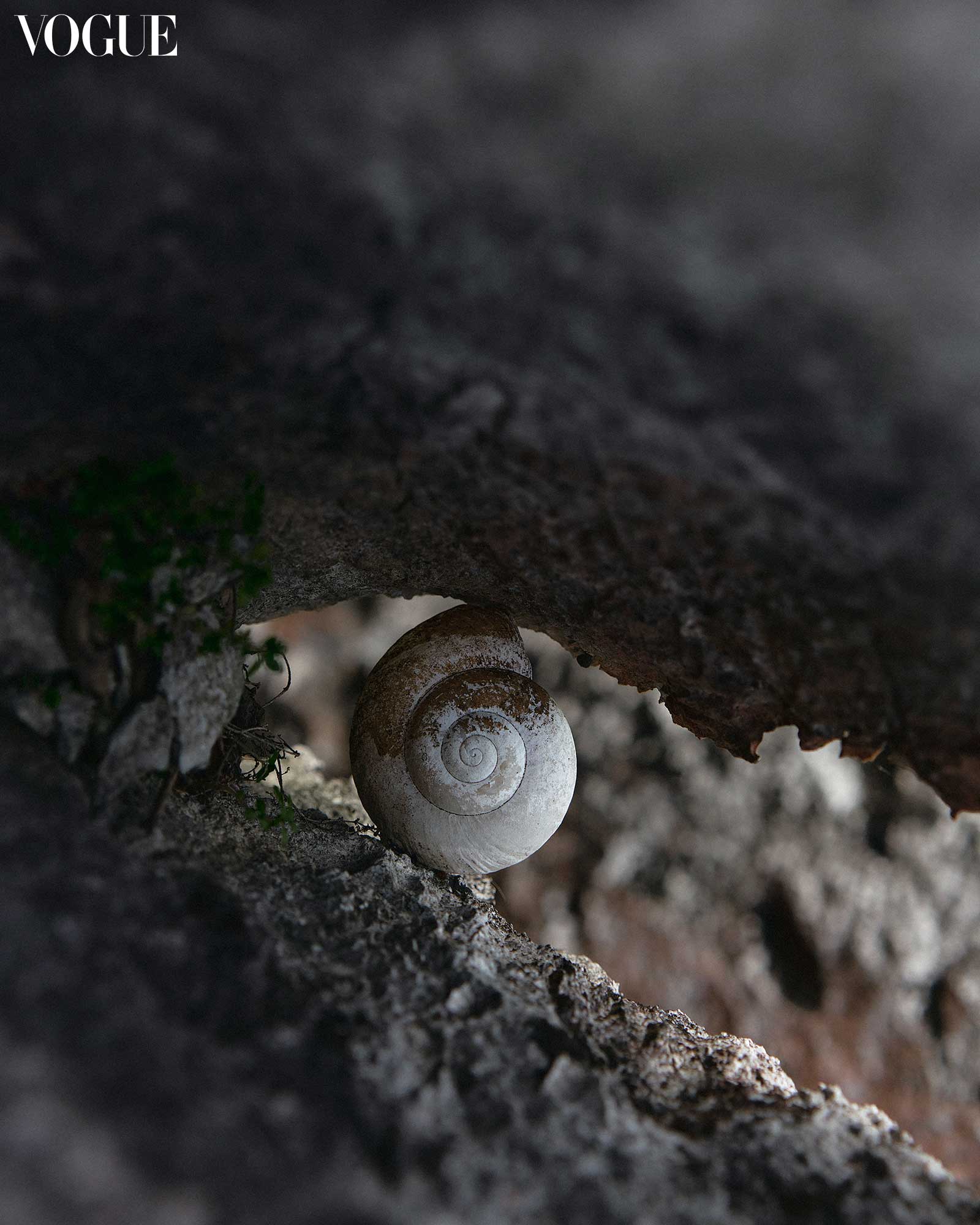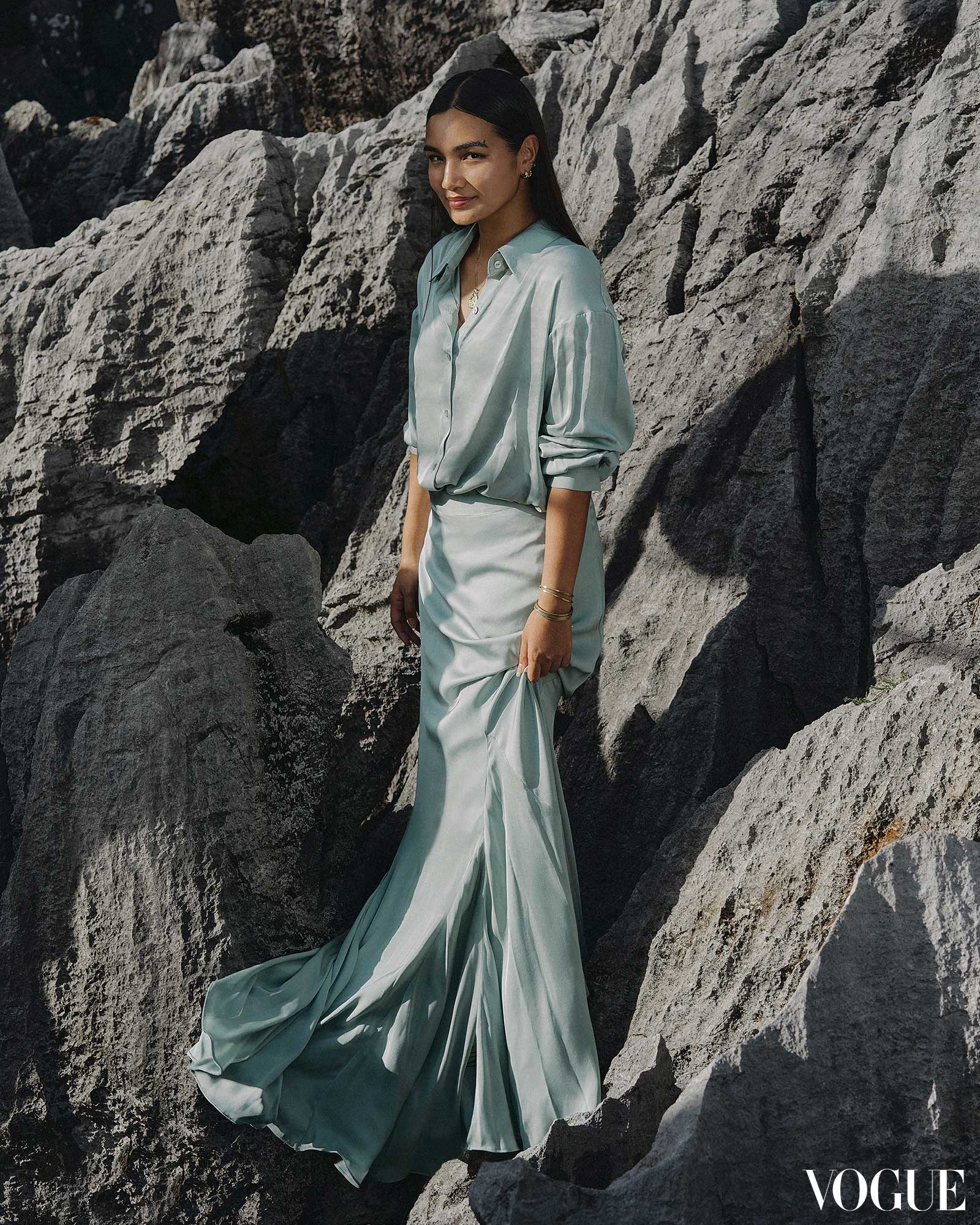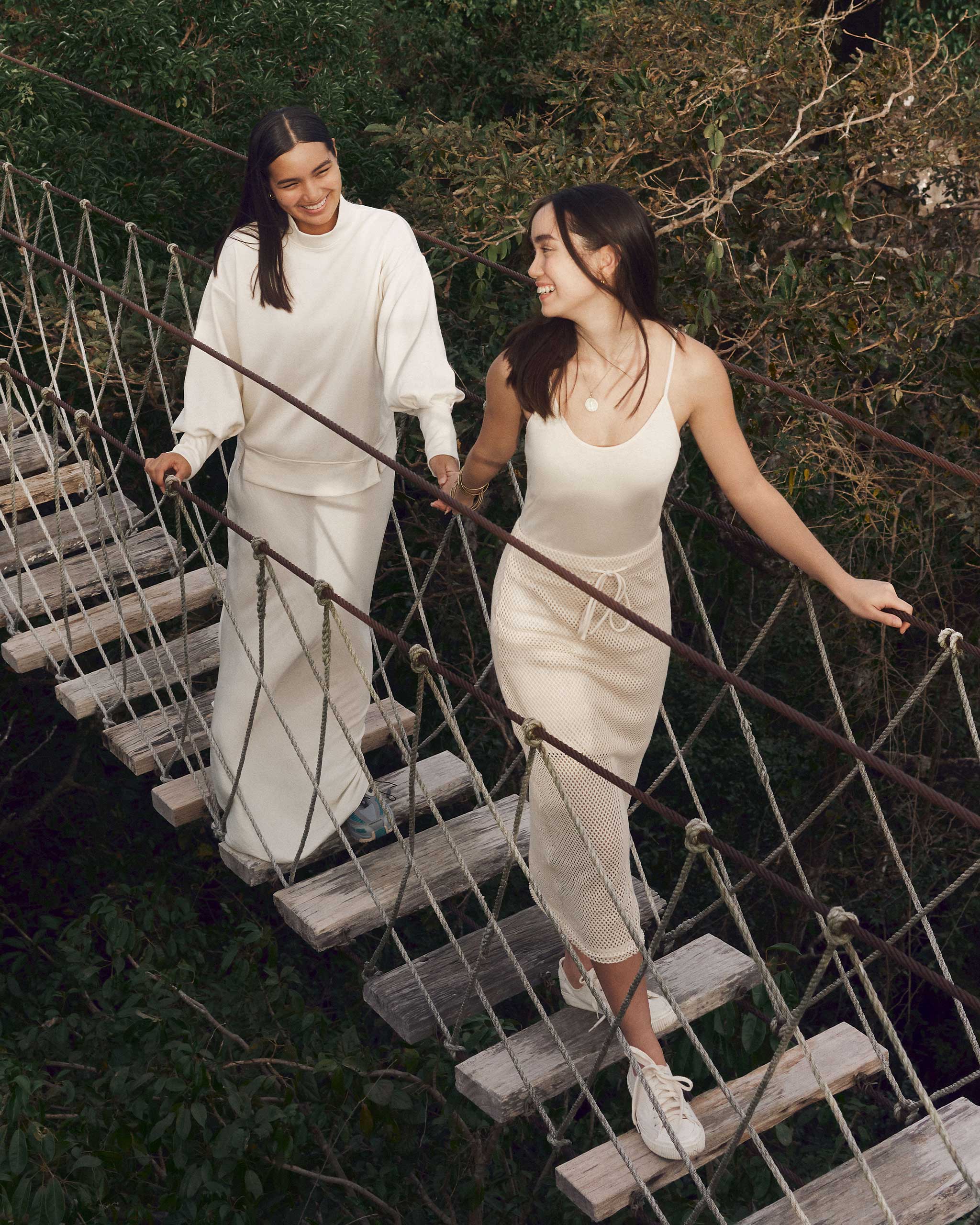Tasha wears a MOON RIVER top, APARA maxi skirt, SALOMON sneakers at R.O.X. Bella wears HINDY WEBER net skirt. Photographed by Artu Nepomuceno for the February 2024 Issue of Vogue Philippines
Tasha and Bella Tanjutco believe that creative thinking will lead to impactful change in climate work.
“Imagine if you could fill up a conference room in Glasgow with the amount of flood water that filled up our communities [in the Philippines],” says Natasha Tanjutco.
She and sister Isabella wanted to conjure this image in the minds of the leaders present at the first Conference of Parties (COP) they attended in 2021. In the air-conditioned rooms in Glasgow, Scotland, the sisters felt that the people making important climate decisions were disconnected from the reality they experience on the ground in the Philippines.
“The leaders were talking as if the climate crisis was going to happen in the next five to 10 years,” Tasha says. But growing up working with urban and island communities in the archipelago, the sisters already knew that the climate crisis was happening.

From that experience abroad, they realized that the answer to the climate crisis was in their creative identity and culture as Filipinos. Years of research and grassroots community building with their youth organizations, TAYO House of Culture & Creativity and Kids for Kids, has helped them understand that Filipino culture has always been creative and collaborative. And, if world leaders are making decisions from so far away, then creativity will step in and act as a bridge for ideas that catalyze decisive change.
Proof of concept for their approach is the Kapuluan ng Kabataan movement, where they work in partnership with young designers and remote communities to build creative spaces and cultural sanctuaries across the archipelago. They hope to build a climate school on an island that is in the process of disappearing.
In Isla Halian, an hour of sailing away from General Luna, Siargao, the coastline has receded about five meters within the past five years. Aside from helping out with typhoon recovery and food security, the sisters’ organizations are doing what they can to keep the island’s biodiversity and culture alive. This includes nurturing the area’s turtle hatchlings, providing creative workshops for the local youth, and sharing the stories of the island community’s lively history.
“If you’re able to use imagination to make people understand the reality [of the climate crisis], then you can come up with actual solutions,” Tasha explains. A hurdle in their climate work has been to dismantle outdated notions on creativity. Having a mother who was an art educator has made it easy for the sisters to see the transformative value of creativity, but people may believe that their push to fuse art and imagination with these hard hitting issues is a failure to understand the gravity of the problems they’re tackling.

But they believe that this creative thinking is what will get more people on board to achieve impactful change. Essential is the belief that creativity is not limited to visual art; it can also come in the form of ideas and creative solutions. Communication has to be factored in climate work. This is why an idea as simple as imagining a flooded Glasgow conference room, for example, can spark an urgent political discussion.
“When we inject art and creativity [with the climate advocacy], people often mistake that we’re not taking this seriously,” Tasha says. “But we don’t want the conversation on climate solutions to be an echo chamber,” says Bella. “We also want to educate people who want to know about what is happening but are too intimidated to enter the space or understand all the complicated jargon.”
They’ve seen success in this framework with their recent work for the Arts & Culture & Creative Industries Bloc of the Congress (ACCIB). Together with the coalition of legislators, they poured over government documents and hours-long congress meeting notes to lobby for the Philippine Creative Industries Development Act, which was successfully passed last year. Through heavy research and creative solutions, they turned white paper documents into a series of fun and colorful collaterals that educated Filipinos online about the bill and how creativity, art, music, and food intersects with the economy.
With that approach, what becomes the core of their climate work is an effort to remind the world that the climate crisis is a humanitarian crisis. They hope people will see that the gravity of these creative and indigenous solutions is just as dense as the problems they are addressing.

The tides seem to be shifting in this direction. Last November, Kids for Kids received a Philanthropic Excellence Award for Children, placing them among the ranks of longstanding companies such as Estée Lauder, the Jollibee Group Foundation, and National Bookstore. The sisters also deem the most recent COP in Dubai to be more successful as there was now a (small, but hopefully growing) platform for indigenous people to speak on their climate concerns.
Reflecting on the eventful year they have had, Bella and Tasha share that the longest journey in their line of work is from their head to their hands. How can they transform data and theory, already abundant in the climate conversation, into effective solutions?
“One thing people forget is that before it gets to your hands, it has to pass through your heart,” says Tasha. Adds Bella,“[Our solutions] can be backed by science but it can be solved by culture and humanity”.
They, and many other climate advocates on the ground around the country have also seen that Indigenous wisdom— which is, knowledge innate to our Filipino culture—has always been where our solutions lie. There is a pre-colonial belief that things that come from the ground have to come back to it, and it predates newly-coined concepts popularized today, such as the circular economy. As Bella says, “As humans, we’re made to co-create with the world we are in.”
By Patricia Villoria. Photographs by Artu Nepomuceno. Fashion Director: Pam Quiñones. Beauty Editor: Joyce Oreña. Stylists: Renee de Guzman, Roko Arceo. Makeup: Angeline Dela Cruz. Hair: JA Feliciano, Mong Amado. Talents: Ann Dumaliang, Bella Tanjutco, Billie Dumaliang, Camille Rivera, Issa Barte, Nicola Sebastian, Tasha Tanjutco. Art Director: Jann Pascua. Producers: Anz Hizon, Bianca Zaragoza. Multimedia Artist: Gabbi Constantino. Production Assistant: Bianca Custodio, Patricia Co, Patricia Villoria, Tinkerbell Poblete. Photographer’s Assistants: Aaron Carlos, Choi Narciso, Mark Tijano, Odan Juan, Sela Gonzales, Rojan Maguyon. Stylist’s Assistants: Giselle Barnachea, Neil De Guzman, Ticia Almazan. Makeup Assistant: Jian Santos. Hair Assistants: Kyle Denzel Celis, Marjorie Caballos. Shot on location at Masungi Georeserve.
- Riding Waves, Growing Stories: Nicola Sebastian’s Path To Climate Justice In The Philippines
- A Lifetime Of Growing And Protecting Forests: Ann And Billie Dumaliang On Their Ongoing Battle For Conservation At Masungi Georeserve
- Issa Barte On Amplifying Indigenous Voices And The Role Of Culture In Climate Action
- Camille Rivera On Bringing Life Back To Communities Through Mangrove Conservation

